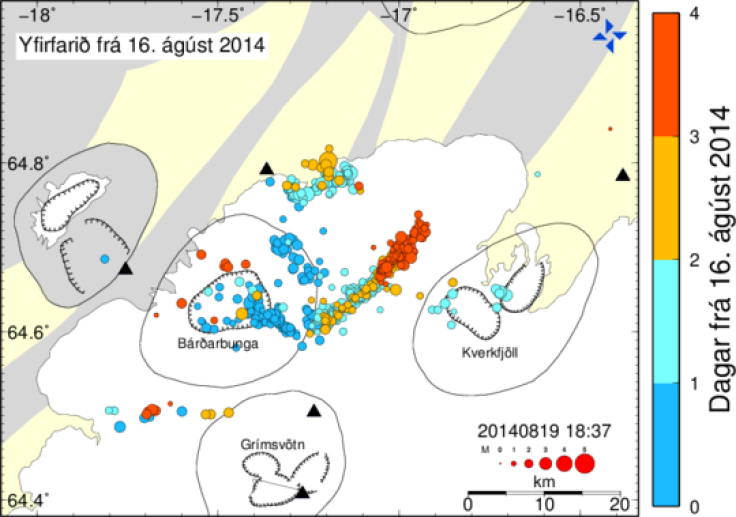Iceland Volcano Bardarbunga: 1,000 Earthquakes Detected Near Volcano, Adding To Fears Of A Potential Explosion

An intense earthquake swarm continues to rattle Iceland’s Bardarbunga volcano, adding to fears that a potential eruption could disrupt the region’s air traffic. Weather officials say they detected about 1,000 small quakes through Tuesday night, which were triggered by an unusually strong earthquake on Monday. The tremors are tied to the increasing movement of magma underground.
“Similar to recent days, two pulses of comparably strong seismic activity have been measured between 04:00 (GMT) and 08:00 this morning, as well as 16:00 and 18:30 in the afternoon,” the Icelandic Met Office wrote on Tuesday night, according to a post published this morning.
Met officials this week issued an “orange” aviation warning – the fourth-highest on a five-grade scale – following a magnitude-4.0 earthquake on Monday, the strongest in the region since 1996. The warning indicates “heightened or escalating unrest with increased potential of eruption.” The Bardarbunga last erupted in 1910, though according to the Met Office, seismic activity has been gradually increasing around the volcano over the past seven years.
Officials published a summary of all regional earthquake activity since the onset of the swarm on Saturday. Blue dots show the earliest quakes while orange dots show the most recently recorded activity. Light blue and yellow dots represent the tremors in-between.

As of now, the Met Office says there are still no signs of magma moving to the surface near the Bardarbunga. The conical “stratovolcano” is located beneath Vatnajokull, Europe’s biggest glacier, and stretches 15.5 miles wide and nearly 6,300 feet above sea level.
The Grimsvotn volcano, just south of Bardarbunga, erupted in May 2011, spewing an ash cloud into the air and forcing flight cancellations in Scotland, northern England and Germany. The Eyjafjallajokull volcano is farther southwest, near Iceland’s Atlantic-facing coast. Eyjafjallajokull's eruption in April 2010 caused airlines to cancel more than 10,000 flights.
© Copyright IBTimes 2024. All rights reserved.











